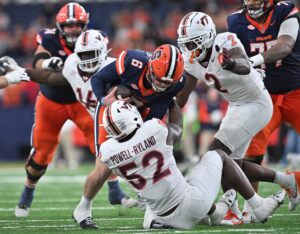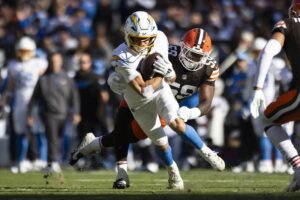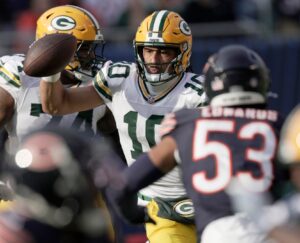Over the summer it is important to establish a baseline for the up and coming potential NFL draft class. You scout the players and take notes on what their strengths and weaknesses are as well as what they can improve on to increase their potential draft stock. This is how you can better access a player’s growth over a season. It also gives you a better understanding of who they are as a player.
Below I have highlighted my early top running backs for the 2019 NFL draft going into the college football season. It is important to remember that these rankings are subject to change throughout the season and most definitely will as players either improve or decrease their stock based on in-season performance.
Chekc out the 2019 quarterback preview here.
Way Too Early 2019 NFL Draft Running Back Preview
David Montgomery, Iowa State
Entering the college football season, it is no surprise that Montgomery is the early top running back. He is a complete back who can serve as a running and receiving threat versus any defense.
He’s very elusive, especially in open field tackle opportunities. Montgomery offers a great combination of strength, contact balance, and receiving ability which makes him stand out as a top guy on tape. One of the biggest traits a running back needs to possess for the next level is contact balance. This refers to a runner’s ability to maintain his balance and speed through contact while continuing to gain yards with ease. This is an area where Montgomery excels at and what really stood when out on film.
Montgomery struggles with being indecisive at the line of scrimmage. Many times, he will try to wait too long for a hole to form instead of bouncing it outside. This could lead to many tackles for a loss at the next level.
He also struggles with his immediate vision. This could be a product of his indecisiveness at the line of scrimmage. Many times, he fails to see oncoming blitzers or tackles. He needs to improve on learning to get a better feel for coverages and where the defense is lined up at. This will help him improve his intermediate vision and allow him to hit the correct holes at a greater rate.
Rodney Anderson, Oklahoma
Anderson burst onto the scene in 2017 after being stuck behind Samaje Perine and Joe Mixon on the depth chart. Though Anderson couldn’t crack 1,000 yards in his first full season of starting he averaged 5.9 yards a carry and managed 11 touchdowns on only 162 carries. He also was able to account for 283 yards and five touchdowns through the air on only 16 receptions.
Anderson is a good athlete with great burst and vision to cover ground quickly and efficiently. He also offers good decision making both downfield and at the line of scrimmage. He hits the hole fast and has the vision and elusiveness to see upcoming defenders and avoid them. On the tape, his burst is one thing that stood out. He can accelerate through a hole fast when he sees it and that allows him to gain yards quickly.
While Anderson was buried on the depth chart he also suffered injuries his first two seasons at Oklahoma. This is concerning and may be an obstacle he will have to overcome during the pre-draft process whenever he decides to declare. Anderson lacks the technique and power to stop defenders in blocks. His lack of power also shows in his inability to gain extra yards at the point of contact at times. This is an area where he needs to show some improvement to be a true between the tackles guy at the next level.
Bryce Love, Stanford
Perhaps one of the most recognizable backs in college football, Love exploded in 2017 finishing second in the Heisman race. Even though Love was stuck behind All-American Christian McCaffery in 2016, he was still able to manage 783 rushing yards. After a full year of being the lead guy for Stanford, Love finished the year with 2,118 yards. Only second in the nation behind newly acquired Seattle Seahawks rookie running back Rashaad Penny.
When watching tape on Love the first thing that pops off the screen is his speed. And man is he fast. Many times, he can completely take over plays based solely on his speed and burst alone. His speed makes him a home run threat every play and will certainly keep defenses on their toes. He also is a patient runner. He does a good job letting the blocks develop and the hole form before accelerating through it.
During passing downs Love shows a willingness to block but is limited many times due to his size and lack of power. His lack of power is also evident at times in his running. He shows an inability to use his power versus a defender. Many times, this leads to him being brought down easily by tackles.
Love also is very inexperienced in the receiving game which is a concern. He plays in the same offense that allowed McCaffery to have 99 catches during his career. Love received only six catches last season. This poses a question of his receiving ability and if he could be used as a pass catcher at the next level.
Damien Harris, Alabama
Harris is the perfect back for you if you want a between the tackles power runner. He offers a good combination of strength, power, and finish ability to excel between the tackles at the next level. As a running back, Harris is well rounded. He is good at a little bit of everything but doesn’t have an elite trait that makes him stand out.
He has the vision and agility to excel between the tackles. Harris also provides the size wanted for a downhill runner, being listed at 5’11” 221 pounds. Harris also offers good pass blocking ability.
Out of the backfield, Harris tends to struggle as a pass catcher. Throughout his career, he as only had 26 catches spread out between three years. This may pose a problem for a team, as the NFL is leaning more towards versatile running backs who can cause damage both on the ground and through the air.
Devin Singletary, FAU
Devin Singletary is one of the underrated running backs in college football. Coming out of FAU he isn’t known to most despite finishing fourth in rushing yards in the FBS in 2017. Singletary finished the season with 1,796 rushing yards. Not only that but he finished first in FBS with 29 touchdowns, ten more than the next running back.
While Singletary might not have the greatest speed, he makes up for it with his impressive burst and elusiveness. He is a home run threat no matter where on the field the offense is. Most of this is because of his field vision and burst through the hole. He can take off when he sees the opportunity, and that opportunity comes a lot thanks to his awareness of the field and where the defense is lined up.
While Singletary can process the field properly he also can be very indecisive at the line of scrimmage at times. This has led to the pocket collapsing on him and getting tackled for a loss. Being a smaller back his ability to break tackles is below average. He is constantly able to be taken down relatively easily with any sort of power behind the tackle. He should also look to improve on his pass blocking technique as it could use some work.
Honorable Mention: Justice Hill, Oklahoma State
Hill first stood out to me watching an Oklahoma State game earlier this past season. He broke a few big plays and really got on my radar. After watching some film of him, it’s safe to say his ability lines up with what I saw during that game.
Hill has rushed for over 1,000 yards the past two season. During that time, he has shown a running back with great speed and ability to create yardage. He is a shifty back who can use his athleticism and elusiveness to gain yards. As a runner, he provides great lateral quickness and can use this to juke out defenders in the open field.
Due to his size, he is very limited in his power. Like other backs on this list, he is smaller than average, being the smallest listed. He lacks the power to throw defenders off their assignments and fails to make an impact in pass blocking often because of this. As a runner, he fails to gain extra yards because he doesn’t have the power to drive for them. Hill also lacks the ability to make a difference in the passing game.
Main photo:
Embed from Getty Images






